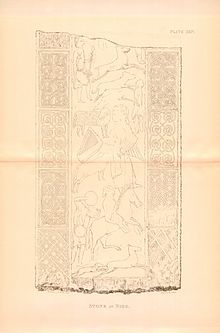Nigg Stone



TheNigg Stoneis an incomplete Class IIPictish cross-slab,perhaps dating to the end of the 8th century.[1]
The stone was originally located at the gateway to the grounds of theparish churchofNigg,Easter Ross,Scotland. It is one of the finest surviving Pictish carved stones, and one of the most elaborate carved stones surviving from early medieval Europe. It is now displayed, restored to its original proportions, in a room inside the parish church (open in summer; key kept locally). It bears an elaborately decoratedcrossin high relief on the 'front' and a figural scene on the reverse. This scene is extremely complicated and made more difficult to interpret by deliberate defacement. Among the depictions are two Pictish symbols: aneagleabove aPictish Beast,a sheep, the oldest evidence of a European triangularharp,and hunting scenes. Scholars interpret the scene as representing a story of the biblicalKing David.The carvings on the cross side show close similarities to the contemporary high crosses ofIona.These works may indeed have been made by the same 'school' of carvers, working for different patrons.
The stone was shattered in the 18th century. The upper and lower parts were crudely joined together using metal staples (now removed), and the shattered intervening part was discarded. Part of the missing fragment was recovered in 1998 by Niall M Robertson, in the stream which runs below the mound on which the churchyard is set, having probably been thrown down the bank at the time the slab was 'repaired'. This small fragment shows most of the 'Pictish beast' symbol, and was preserved inTainMuseum, until being reattached during a restoration in 2013.[2]
It is ascheduled monument.[3]
Notes
[edit]- ^"STAMS, University of Strathclyde, UK: Pictish Stones Search Facility".Archived fromthe originalon 26 December 2007.Retrieved27 December2006.
- ^"Easter Ross's Nigg cross-slab restoration completed".BBC News. 10 April 2013.Retrieved11 April2013.
- ^Historic Environment Scotland."Nigg Church, Pictish symbol-bearing cross-slab (SM1680)".Retrieved24 February2019.
References
[edit]- Fraser, Iain, Ritchie, J.N.G.,et al.,Pictish Symbol Stones: An Illustrated Gazetteer,(Royal Commission on the Ancient and Historical Monuments of Scotland, 1999)
- Jones, Duncan,A Wee Guide to The Picts,(Musselburgh,2003)
- MacNamara, Ellen,The Pictish Stones ofEaster Ross,(Tain,2003)
- Scott, Douglas,The Stones of the Pictish Peninsulas,(HiltonTrust, 2004)
External links
[edit]- Am Baile
- Strathclyde UniversitySTAMS Pictish Stone Search Facility.
- Nigg Old Trust
